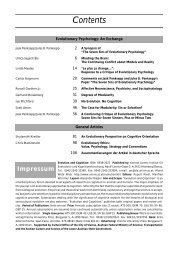Contents - Konrad Lorenz Institute
Contents - Konrad Lorenz Institute
Contents - Konrad Lorenz Institute
You also want an ePaper? Increase the reach of your titles
YUMPU automatically turns print PDFs into web optimized ePapers that Google loves.
Vertical and Horizontal Learning<br />
as a system meant to increase the probability of immediate<br />
survival. Organisms responsive to information<br />
that would be potentially harmful or stimulating<br />
would be favoured over organisms with less<br />
well adapted monitoring capabilitites. This simple<br />
fact is crucial to the evolutionary invention of the<br />
learning system (CHURCHLAND 1986; DENNETT<br />
1996). For the implicit learning device to acknowledge<br />
and categorize encounters into harmful and<br />
productive recurrence of events are conditional.<br />
Monitoring seemingly neutral stimuli signaling<br />
the occurrence of either harmful or productive<br />
stimuli (central to almost all sorts of conditioning<br />
processes) increases the survival capacity. If an organism<br />
can anticipate events by monitoring cue<br />
signals, it is one step ahead of reality. Therefore<br />
context matters. In comparison, a learning device<br />
worked out to register information which is seldom<br />
repeated or barely had any consequences<br />
would be outcompeted and therefore not implemented<br />
in the gene pool of the generations to<br />
come. Learning systems focused on environmental<br />
regularities will tend to be sensitive to a broad<br />
range of stimuli, combining and storing different<br />
stimulus modalities to obtain as much information<br />
as possible. Incidently, this explains why implicit<br />
learning is applicable to all our senses. Being receptive<br />
to any event however insignificant, because of<br />
its predicitive powers is to focus on relations and<br />
interconnectivity of variables.<br />
The crux of the matter is as follows: Implicit<br />
learning capabilities emerged to monitor intricate<br />
patterns of information of survival value to the organism.<br />
To register relations and interdependency<br />
of stimuli is to learn about context. Hence, implicitly<br />
learned material retain context and becomes<br />
correspondently committed to specific learning<br />
situations to a greater extent.<br />
Explicit and implicit learning systems interpret<br />
the environment differently as regards detachment<br />
from context. Implicit learning relates to information<br />
as pieces in a jigsaw puzzle relate to the picture<br />
they represent. By using an implicit learning strategy<br />
one might not identify all relationships due to a<br />
number of pieces being missing, but one might still<br />
get a fairly good representation<br />
of the overall picture. On<br />
the contrary, using an explicit<br />
learning strategy corresponds<br />
to choosing a few significant<br />
pieces to get a general idea (by<br />
educated guesses) of the<br />
whole by disregarding a large<br />
Author’s address<br />
Theresa S. S. Schilhab, Learning Lab Denmark,<br />
Danish University of Education, Emdrupvej<br />
101, DK-2400 Copenhagen NV.<br />
Email: theresa@lld.dk<br />
amount of less significant pieces of information. In<br />
the explicit condition if one chooses pieces of sky,<br />
ground and corners the impression applies to a multitude<br />
of pictures. Whereas in the implicit condition<br />
the extra pieces of for example birds, houses and<br />
telephone poles fill in relations to determine this<br />
particular picture.<br />
Horizontal and Vertical Learning<br />
To summarise; implicit learning is adapted to monitor<br />
intricate patterns whereas the benefit of explicit<br />
learning is to abstract material from relations and<br />
contexts, to gather and store particular information<br />
in a universal format that can be applied in a new<br />
context. The independence of actual events makes<br />
the learned material mentally manageable which can<br />
eventually be passed on to other individuals.<br />
For any organism, the first priority is to stay alive.<br />
Hence abilities to divide immense amounts of information<br />
into essential (life preserving) and non essential<br />
(unimportant to life preservation) information<br />
will be aimed at stimuli that show some sort of<br />
repetition and form part of a recognizable pattern,<br />
specific to a learning incident. Disclosing structures<br />
that are vertically oriented becomes essential and<br />
results in the learning not being applicable to different<br />
contexts.<br />
On the other hand, the explicit learning system<br />
was developed on top of the implicit system, not as<br />
an alternative solution to replace implicit learning<br />
devices. Thus, explicit learning, that supplements an<br />
already well functioning implicit learning system, is<br />
adapted to obtain information irrespective of contextual<br />
relations. The explicit learning system can be applied<br />
to a wider range of information processing. For<br />
example, it has no need for stimuli to be constant or<br />
repetitive, in order to operate. In many instances,<br />
one exposure to a particular stimulus is sufficient for<br />
later storage. Because of being widely independent of<br />
context it can also be applied to different contextual<br />
settings which makes it horizontally oriented. Explicit<br />
learning capabilities (especially context independency)<br />
were beyond any doubt fundamental to<br />
the cultural progress of humans as viewed by advanced<br />
tool making (DAVID-<br />
SON/NOBLE 1993; NOBLE/<br />
DAVIDSON 1996). The superiority<br />
of human intelligence, in<br />
particular its versatility, is due<br />
to the sophistication of the explicit<br />
learning device (e.g.;<br />
BENNETT 1988, 1997).<br />
Evolution and Cognition ❘ 175 ❘ 2003, Vol. 9, No. 2








